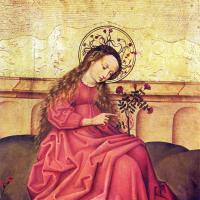Antonio Vivaldi (1678–1741)
Gloria in D RV589
for two sopranos, alto, chorus and orchestra
Vivaldi composed this Gloria in Venice, probably in 1715, for the choir of the Ospedale della Pietà, an orphanage for girls (or more probably a home, generously endowed by the girls’ ‘anonymous’ fathers, for the illegitimate daughters of Venetian noblemen and their mistresses). The Ospedale prided itself on the quality of its musical education and the excellence of its choir and orchestra.
Vivaldi, a priest, music teacher and virtuoso violinist, composed many sacred works for the Ospedale, where he spent most of his career, as well as hundreds of instrumental concertos to be played by the girls’ orchestra. This, his most famous choral piece, presents the traditional Gloria from the Latin Mass in twelve varied cantata-like sections.
The wonderfully sunny nature of the Gloria, with its distinctive melodies and rhythms, is characteristic of all of Vivaldi’s music, giving it an immediate and universal appeal.
- Gloria in excelsis Deo (chorus)
- Et in terra pax (chorus)
- Laudamus te (two sopranos)
- Gratias agimus tibi (chorus)
- Propter magnam gloriam (chorus)
- Domine Deus (soprano)
- Domine, Fili unigenite (chorus)
- Domine Deus, Agnus Dei (alto and chorus)
- Qui tollis peccata mundi (chorus)
- Qui sedes ad dexteram Patris (alto)
- Quoniam tu solus sanctus (chorus)
- Cum Sancto Spiritu (chorus)
Like the other works in tonight’s programme, the Gloria is in D, the key of rejoicing. The opening movement is a joyous chorus, with trumpet and oboe obbligato. The extensive orchestral introduction establishes two simple motives: one of octave leaps, the other a quicker, quaver-semiquaver figure; these function as the ritornello. The choir enters in chorale-like fashion, syllabically declaiming the text in regular rhythms, contrasting with the orchestral ritornello, which contains most of the melodic interest of the movement.
The B minor ‘Et in terra pax’ is in nearly every way a contrast to the first. It is in triple rather than duple time, in a minor key, and rather slower. Its imitative and expressive chromatic texture evokes the motets of the Renaissance era, the so-called ‘stile antico’. ‘Laudamus te’, a lively duet for the two sopranos, gives us some hint of the skill of Vivaldi’s young singers. ‘Gratias agimus tibi’ is a very broad and entirely homophonic prelude to a fugal allegro on ‘Propter magnam gloriam’.
The Largo ‘Domine Deus, Rex coelestis’ is in the form of a duet between the solo soprano and the solo violin, followed by the joyful F major ‘Domine Fili unigenite’ chorus in what Vivaldi and his contemporaries would have regarded as the ‘French style’. It is dominated by the dotted rhythms characteristic of a French overture. ‘Domine Deus, Agnus Dei’ features the alto soloist, with the chorus providing an antiphonal response, ‘qui tollis peccata mundi’, to each intercession.
The bold harmonies of the following section, ‘Qui tollis’, provide a refreshing change of tone colour, and complement the intercessional alto aria, ‘Qui sedes ad dexteram Patris’. The string accompaniment contains recollections of the opening movement, and prepares for the following movement, ‘Quoniam tu solus sanctus’, which takes the shape of a brief reprise of the opening movement’s broken octaves.
The powerful ‘stile antico’ double fugue on ‘Cum Sancto Spiritu’ that ends the work is an arrangement by Vivaldi of the ending of a Gloria per due chori composed in 1708 by an older contemporary, the now forgotten Veronese composer Giovanni Maria Ruggieri, whom Vivaldi seems to have held in high esteem, as he used a second adaptation of this piece in another, lesser-known D Major Gloria setting, RV 588.
Today Vivaldi is one of the most popular of all composers, who during his lifetime enjoyed considerable success and fortune, which he squandered through extravagance, and when he died in Vienna he was buried in a pauper’s grave. For two centuries after his death, the Gloria lay undiscovered until the late 1920s, when it was found buried among a pile of forgotten Vivaldi manuscripts.
However, it was not performed until September 1939 in Siena in an edition by the composer Alfredo Casella. This was by no means an authentic edition (he described it as an ‘elaborazione’), as he embellished the original orchestration of trumpet, oboe, strings and continuo, while reducing the role of the continuo, and cut sections from three movements. It was not until 1957 that the now familiar original version was published and given its first performance at the First Festival of Baroque Choral Music at Brooklyn College, NY.
Gloria in excelsis Deo.
Et in terra pax hominibus bonae voluntatis.
Laudamus te, benedicimus te,
Adoramus te, glorificamus te.
Gratias agimus tibi
propter magnam gloriam tuam.
Domine Deus, Rex coelestis,
Deus Pater omnipotens.
Domine Fili unigenite, Jesu Christe.
Domine Deus, Agnus Dei, Filius Patris.
Qui tollis peccata mundi,
miserere nobis.
Qui tollis peccata mundi,
suscipe deprecationem nostram.
Qui sedes ad dexteram Patris,
miserere nobis.
Quoniam tu solus Sanctus, tu solus Dominus,
Tu solus Altissimus, Jesu Christe,
Cum Sancto Spiritu
in gloria Dei Patris. Amen.
Glory to God in the highest.
And on earth peace to men of good will.
We praise you, we bless you,
We adore you, we glorify you.
We give you thanks
for your great glory.
Lord God, King of Heaven,
God the Father Almighty.
Lord, only-begotten Son, Jesus Christ.
Lord God, Lamb of God, Son of the Father
You who take away the sins of the world,
have mercy on us.
You who take away the sins of the world,
receive our prayer.
You who sit at the right hand of the Father,
have mercy on us.
For you alone are holy, you alone are Lord,
You alone are the Most High, Jesus Christ,
With the Holy Spirit
in the glory of God the Father. Amen.
Composer: Vivaldi Wiki Link: http://en.wikipedia.org/wiki/Gloria_%28Vivaldi%29 Title of Musical Work: Gloria
